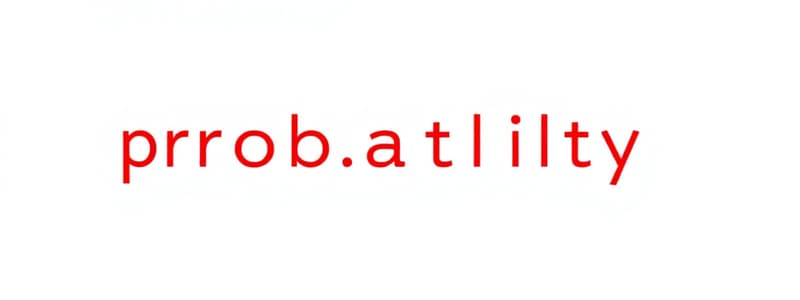Podcast
Questions and Answers
A researcher performs an experiment involving drawing marbles from a bag. Which scenario represents an 'event' in the context of probability?
A researcher performs an experiment involving drawing marbles from a bag. Which scenario represents an 'event' in the context of probability?
- The researcher draws three marbles and observes that exactly two of them are blue (correct)
- The researcher calculates the total number of marbles in the bag before the experiment begins.
- The researcher records the color of each marble drawn and then replaces it.
- The researcher ensures that the marbles are well-mixed inside the bag.
In a game with a spinner divided into equal sections numbered 1 through 20, what outcome would be considered a 'simple event'?
In a game with a spinner divided into equal sections numbered 1 through 20, what outcome would be considered a 'simple event'?
- Spinning the spinner five times and recording each result.
- Spinning the spinner and landing on the number 13. (correct)
- Spinning the spinner and landing on an even number.
- Spinning the spinner until a prime number is obtained.
A bag contains 5 red balls, 3 blue balls, and 2 green balls. If a ball is drawn at random, what is the probability of NOT drawing a blue ball?
A bag contains 5 red balls, 3 blue balls, and 2 green balls. If a ball is drawn at random, what is the probability of NOT drawing a blue ball?
- $1/10$
- $7/10$ (correct)
- $3/10$
- $1/2$
A researcher wants to determine the probability of drawing a queen from a standard 52-card deck. Given this scenario, which statement accurately describes how this probability should be calculated?
A researcher wants to determine the probability of drawing a queen from a standard 52-card deck. Given this scenario, which statement accurately describes how this probability should be calculated?
A six-sided die is rolled. What is the probability of rolling a number that is either even or less than 3?
A six-sided die is rolled. What is the probability of rolling a number that is either even or less than 3?
A bag contains 3 green balls and 4 yellow balls. What is the probability of drawing two green balls in a row, without replacing the first ball?
A bag contains 3 green balls and 4 yellow balls. What is the probability of drawing two green balls in a row, without replacing the first ball?
A lottery machine picks five digits, each from 0 to 9. What is the probability that the lottery number will be a palindrome (reads the same forwards and backward)?
A lottery machine picks five digits, each from 0 to 9. What is the probability that the lottery number will be a palindrome (reads the same forwards and backward)?
If the probability of event A is $p$, what is the probability of its complementary event, denoted as A'?
If the probability of event A is $p$, what is the probability of its complementary event, denoted as A'?
A standard six-sided die is rolled twice. What is the probability that the first roll is a 2 and the second roll is greater than 4?
A standard six-sided die is rolled twice. What is the probability that the first roll is a 2 and the second roll is greater than 4?
A card is drawn at random from a standard deck of 52 cards. Define event A as drawing a heart, and event B as drawing a king. If A and B are complementary, what the probability of A not occurring?
A card is drawn at random from a standard deck of 52 cards. Define event A as drawing a heart, and event B as drawing a king. If A and B are complementary, what the probability of A not occurring?
Flashcards
What is a Trial?
What is a Trial?
A single instance of a well-defined, repeatable procedure or test.
What is an Outcome?
What is an Outcome?
The result of a trial, such as getting heads on a coin flip.
What is an Event?
What is an Event?
The outcome of one or more trials.
What is Probability?
What is Probability?
Signup and view all the flashcards
What is a Simple Event?
What is a Simple Event?
Signup and view all the flashcards
Compound Event
Compound Event
Signup and view all the flashcards
Probability of a Compound Event
Probability of a Compound Event
Signup and view all the flashcards
Complementary Events
Complementary Events
Signup and view all the flashcards
Probability of a Complementary Event
Probability of a Complementary Event
Signup and view all the flashcards
Examples of Complementary Events
Examples of Complementary Events
Signup and view all the flashcards
Study Notes
- A trial in probability refers to a single instance of a repeatable experiment.
- The outcome is the result of a trial.
- An event is the outcome of one or more trials.
Probability of an Event
- The probability of an event is calculated when all outcomes are equally likely using the formula: (Number of ways the event can occur) / (Total number of possible outcomes).
- The probability of an event indicates its likelihood of occurring, ranging from 0 to 1.
- A probability of 0 means the event is impossible.
- A probability of 1 means the event is certain.
Simple Events
- A simple event is an event with one outcome but typically more than one possible outcome.
- Example simple events: choosing a card from a deck, picking an item of clothing, selecting a letter.
- The probability of choosing an ace from a 52-card deck is 4/52 ≈ 0.077.
- If someone has 12 shirts, the probability of choosing a specific shirt is 1/12 ≈ 0.083.
- The probability of randomly choosing a vowel from the 26 letters of the English alphabet is 5/26 ≈ 0.192.
Compound Events
- A compound event is an event with more than one outcome.
- Example compound events: rolling two dice, selecting digits for a lottery, choosing marbles from a bag.
- The probability of a compound event is calculated by multiplying the probabilities of each outcome.
- The probability of both outcomes A and B occurring is P(A and B) = P(A) * P(B).
- Generally, adding more outcomes to a compound event decreases the probability.
- The probability of rolling a 1 on the first die and a 4, 5, or 6 on the second die when rolling two six-sided dice is (1/6) * (3/6) = 1/12 ≈ 0.083.
- The probability of a lottery number being 12345, where each digit is randomly chosen from 0-9, is (1/10) * (1/10) * (1/10) * (1/10) * (1/10) = 1/100000 = 0.00001.
Complementary Events
- Complementary events are mutually exclusive, and one of them must occur.
- Example complementary events: heads or tails on a coin flip; vowel or consonant; black or red card.
- The sum of the probabilities of two complementary events is 1.
- If outcomes A and B are complementary, P(A) + P(B) = 1, so P(B) = 1 - P(A).
- The probability of choosing a consonant from the English alphabet is 1 - (5/26) = 21/26 ≈ 0.808.
- The probability of getting heads or tails on a coin flip is 1/2.
- The probability of choosing a black or red card from a deck of cards is 1/2.
Studying That Suits You
Use AI to generate personalized quizzes and flashcards to suit your learning preferences.
Description
This lesson defines trials, outcomes, and events in probability. It explains how to calculate the probability of an event when all outcomes are equally likely. Simple events are defined and examples are provided.




